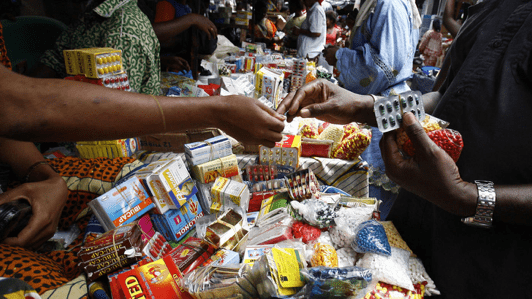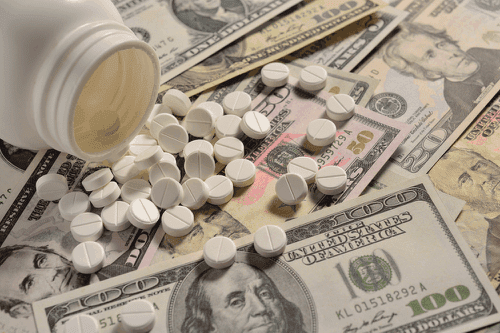Imagine this: you’re traveling through Sub-Saharan Africa on a business trip and begin to develop terrible flu-like symptoms. You head to a local physician for anti-malarial medication and after taking the medicine, your symptoms become progressively worse. The symptoms resemble an allergic reaction and your overall medical condition is quickly deteriorating. In some areas of the world, these effects could simply be perceived as a drug allergy; however, the underlying issue could be much worse while traveling in an unfamiliar area. Following a telemedicine consultation with your local physician in the United States, you are informed that the medication you were prescribed by the Sub-Saharan physician was counterfeit.
This problem is more common than you think.
The Issue
According to the U.S. Food and Drug Administration (FDA), a counterfeit drug is “sold under a product name without proper authorization.” These fabricated drugs often do not contain the proper active ingredients and are improperly packaged.
The prevalence of counterfeit medication poses a major international public health hazard. Interpol, an intergovernmental organization that facilitates international police cooperation, stated that 20.7 million fake medicines were seized in 2015, which equates to $81 billion U.S. dollars. Nevertheless, counterfeit medication seizures are no simple task for protection agencies. Many organizations find it difficult to manage the illegal drug market due to a lack of funding and resources, streamlined communication, and drug identification abilities.
Interpol is also credited with an abundance of operations dedicated to tackling the spread of counterfeit medications. Many of the operations focus on region-specific restrictions while advocating for an international stoppage. Operation Pangea is an international “week of action” bringing together customs, health regulators, national police and the private sector to focus on reducing the spread of online counterfeit drugs. The activities and initiatives generated from Operation Pangea have been responsible for millions of successful seizures.

Worldwide Prevalence
Counterfeit medications pose a threat in every part of the world, and the United States is no exception. Although the U.S. mandates frequent drug testing, some fake medications are overlooked due to scattered agency responsibility. Interpol claims that over half of the medicines confiscated in Operation Pangea are from the United States and other wealthy nations, such as the United Kingdom and France. One of the most infamous U.S. counterfeit drug cases to date was seen in the case of Avastin in 2012. Avastin is a drug used to combat cancer in patients using a monoclonal antibody; however, the drugs that were administered to patients lacked the proper active ingredient. In other words, the fake medication did not inhibit tumor growth and did not provide any source of treatment for the patients. The counterfeit drugs only interfered with the valuable time that patients had to fight for their lives.
The FDA has since established a counterfeit medication warning website to notify citizens of further dangers. Nevertheless, many citizens are unaware of the problem’s severity and the issue has been pushed to the wayside for U.S. international action.
The U.S has had its own issues with counterfeit medication, but more cases occur overseas. Many developing nations lack access to proper resources and screening protocols used to reduce the spread of counterfeits, similar to those used by the U.S. Food and Drug Administration. A lack of funding and resources can severely reduce the efficiency of crackdown policies, and without these agencies and protocols, national healthcare and patients are at an increased risk of susceptibility. As stated in an article by Newsweek, healthcare systems face the greatest danger during a medication shortage. Healthcare officials begin to stray outside the normal supply chain to refill their depletions and are sometimes confronted with surprising results.
Profitable Business
Over the years, the counterfeit drug industry has grown immensely with the forefront ideology of “low risk, high reward.” According to a tropical medicine professor at the University of Oxford, Paul Newton, the consequences for entanglement with counterfeit pharmaceuticals are far less penalizing than those associated with narcotics and human trafficking. Criminals have realized the monetary potential. Additionally, the increased use of online pharmacies and new means of purchasing drugs have created platforms for counterfeit drug manufacturers to exploit. Consumers can now purchase drugs blindly on the internet and have no way of deciphering fake from authentic drugs upon arrival. Producers are hiding behind a computer screen while simultaneously maximizing their profits at no risk. Since the beginning of the decade, the rates of online pharmaceutical purchases have skyrocketed due to a lack required authentication and valid prescriptions. The public now recognizes the ease of access offered by online pharmacies and criminals have simultaneously exploited the public’s reliance.

The sad truth is if people were not making as much money from the counterfeit drug industry, the threat would not exist. Unfortunately, there is money in counterfeit medicine production. A lot of money. According to the United Nations Office on Drugs and Crime, sales from Asia to South-East Asia and Africa alone amount to some $1.6 billion per year. In 2012, the World Health Organization estimated the worth of the counterfeit drug industry: $412 billion dollars. The industry has only continued to grow since this assessment.
Damage
Counterfeit drugs pose a grave danger to consumers. During the manufacturing process, a single pill can pass through a dozen countries providing multiple opportunities for criminals to insert fake drugs into the supply chain. The manufacturer claims to provide the same medication, but dangerous changes are made to reduce production costs and benefit the producer. A few of the most common alterations generated during the process include:
- different medicinal quantities
- insertion of toxic ingredients
- forged information, and;
- manufacturing under improper conditions
Counterfeit medications lacking the proper ingredients and preparation protocols may inhibit a consumer’s treatment and postpone life-saving therapies, inevitably leading to a surplus of perilous symptoms and sometimes death.
A recent case of counterfeit drug use that has rendered international attention is the widespread prevalence of banned antimalarial drugs in Nigeria. The European Union previously banned the use of 42 anti-malarial drugs known to cause kidney failure, however, the drugs are “still being stockpiled, sold, and consumed in Nigeria.” The antimalarial drugs have become increasingly accessible and can be obtained over the counter. Not only does this issue reflect the hazardous nature of the counterfeit industry, but it also reinforces notions of populace exploitation.
Solutions
There is no global consensus or general international movement towards a solution (yet), however, specific organizations have begun enacting legislation to limit the use and spread of counterfeits. In the mid-2000s, the World Health Organization launched a taskforce known as the International Medical Products Anti-Counterfeiting Taskforce (IMPACT) to help reduce the deadly trade of counterfeit drugs. The taskforce was created to work alongside governments and healthcare workers to detect counterfeits and notify authorities of any suspicion. The U.S. Food and Drug Administration also created a taskforce to combat the spread of counterfeit medications through the use of identification and legislation. Although there is no guaranteed cessation of all illegal trade, any hindrance is a good hindrance.
The use of technology has assisted in the fight, as well. New manners of technologically identifying drugs and the integration of collaborative detection databases could potentially reduce the spread of counterfeit drugs while retaining international health diplomacy. The counterfeit industry is a dangerous giant that can only be crushed with global cooperation.
VIGILINT Advantage
One way to ensure that you will not consume counterfeit medications is to prepare ahead of time. VIGILINT offers Travel Medical Kits to clients to ensure access to a safe pharmaceutical supply while traveling. Travel Medical Kits are personalized for each traveler based on health history and potential travel risks, and provide a multitude of medications for unforeseen circumstances. A safe drug supply could distinguish a successful and safe trip from a dangerous one. Contact VIGILINT for all pre-departure needs and travel medical necessities.
